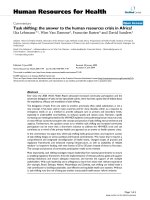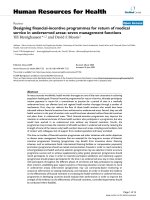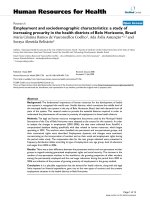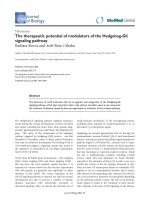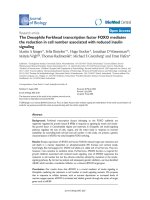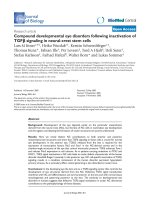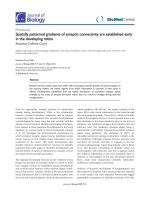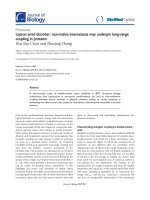Báo cáo sinh học: " Liaison amid disorder: non-native interactions may underpin long-range coupling in proteins" ppsx
Bạn đang xem bản rút gọn của tài liệu. Xem và tải ngay bản đầy đủ của tài liệu tại đây (208.72 KB, 5 trang )
Minireview
LLiiaaiissoonn aammiidd ddiissoorrddeerr:: nnoonn nnaattiivvee iinntteerraaccttiioonnss mmaayy uunnddeerrppiinn lloonngg rraannggee
ccoouupplliinngg iinn pprrootteeiinnss
Hue Sun Chan and Zhuqing Zhang
Address: Department of Biochemistry, Department of Molecular Genetics, and Department of Physics, University of Toronto,
1 King’s College Circle, MSB 5207, Toronto, Ontario, M5S 1A8 Canada.
Correspondence: Hue Sun Chan. Email:
How do the conformational structures, dynamics and bio-
logical function of a protein emerge from the interactions
among its amino acid residues? A significant part of current
ideas about protein behaviors is based on structures in the
Protein Data Bank (PDB) and notions of contact-like inter-
actions between amino acid residues in spatial proximity.
While useful, this picture is limited. In particular, studies of
allostery and mutational analyses have demonstrated that
energetic coupling can exist between residues at positions
far apart in a protein’s native structure. An intriguing
possibility is that such apparently long-range coupling may
arise from the residues’ transient association in the
unfolded state. This scenario was elucidated by an extensive
computational study using two-dimensional lattice protein
models published recently in BMC Structural Biology by the
groups of Ron Unger and Amnon Horovitz (Noivirt-Brik et
al. [1]). Their study provides a theoretical framework that
will be useful for guiding future experiments. It also
highlights the power and versatility of simple lattice
modeling. Despite the highly coarse-grained representations
of polypeptide chains used, this decades-old practice offers
conceptual clarity and has been proved effective time and
again in discovering and elucidating fundamental bio-
physical principles.
CChhaarraacctteerriizziinngg eenneerrggeettiicc ccoouupplliinngg bbyy ddoouubbllee mmuuttaanntt
ccyyccllee
Energetic coupling between amino acid residues is difficult
to discern from the static folded structure of a protein alone.
Double-mutant cycle (DMC) is a direct perturbative tech-
nique to assess the degree to which the consequences of
mutations at two different sites are correlated. DMC
compares the sum of effects of two single mutations on two
sites (one at a time) and the effect of double mutations on
both of the sites. Often, as in Noivirt-Brik et al. [1], the effect
of interest is the free energy of folding, ΔG (native state
more stable for more negative ΔG). If ΔΔG(m
1
), ΔΔG(m
2
),
and ΔΔG(m
1
,m
2
) are, respectively, the changes in ΔG
resulting from two single mutations and from the double
mutations (ΔΔG equals ΔG of the mutant minus that of the
wild type), coupling is quantified by an ‘interaction free
energy’ ΔΔG
int
= ΔΔG(m
1
,m
2
) - [ΔΔG(m
1
) + ΔΔG(m
2
)]. The
two sites are energetically independent if the mutational
AAbbssttrraacctt
A lattice-model study of double-mutant cycles published in
BMC Structural Biology
underscores how interactions in non-native conformations can lead to thermodynamic
coupling between distant residues in globular proteins, adding to recent advances in
delineating the often crucial roles played by disordered conformational ensembles in protein
behavior.
Journal of Biology
2009,
88::
27
Published: 13 March 2009
Journal of Biology
2009,
88::
27 (doi:10.1186/jbiol126)
The electronic version of this article is the complete one and can be
found online at />© 2009 BioMed Central Ltd
effects are additive (ΔΔG
int
= 0). Otherwise they are coupled,
wherein the native state is either stabilized (ΔΔG
int
< 0) or
destabilized (ΔΔG
int
> 0) by coupling. Energetic coupling
may also be estimated using a bioinformatics approach
based on evolutionary assumptions. This indirect method
has also identified likely long-range interactions, for
example in PDZ domains [2].
LLoonngg rraannggee ccoouupplliinngg iinn pprrootteeiinnss ccaann hhaavvee mmuullttiippllee
pphhyyssiiccaall oorriiggiinnss
The existence of long-range coupling should not be sur-
prising. After all, the folded state of a protein may be viewed
as an elastic solid [3]. As such, the vibrational dynamics of
distant sites can be coupled and a ‘pathway of energetic
connectivity’ [2] inside the folded protein is physically
plausible. Without discounting such folded-state mechanisms,
Noivirt-Brik et al. [1] tackled another possibility, focusing
mainly on the unfolded (denatured) state. Because native
stability is determined by the balance between the folded
and unfolded states, interactions in the unfolded states can
have an impact on coupling. This possibility was over-
looked when unfolded states were envisaged to be devoid of
significant contact interactions (Figure 1a), a picture rooted
in a simplistic view of cooperative, two-state-like folding.
However, it is physically reasonable to expect, for instance,
that two hydrophobic residues can associate in the unfolded
state even if they are not in contact in the folded structure.
This idea is embodied in the well-studied hydrophobic-
polar (HP) model, which aims to capture essential protein
physics by using only two residue types (Figure 1b). The HP
model [4] illustrates the same principle as that deduced
from the model with four residue types used by Noivirt-Brik
et al. [1]. Figure 1b shows two residues (red and blue)
exposed in the folded structure, but they can contact other
residues as well as each other in the unfolded state.
RReevveerrssee hhyyddrroopphhoobbiicc eeffffeecctt aanndd ootthheerr mmaanniiffeessttaattiioonnss
ooff nnoonn nnaattiivvee iinntteerraaccttiioonnss
Does the model in Noivirt-Brik et al. [1] and that shown in
Figure 1b reasonably mimic reality? Ample evidence sup-
ports the existence of non-native interactions in protein
unfolded states [5]. As early as 1990, the hydrophobicity of
an exposed residue in the Cro repressor from bacteriophage
λ was found to correlate negatively with the stability of the
protein. Dubbed the ‘reverse hydrophobic effect’ to contrast
it with the usual role of hydrophobicity in stabilizing the
folded state, the phenomenon was rationalized by the pro-
posal that the residue is partially buried; that is, it has non-
native contact(s) in the unfolded state [6]. The variation in
the denaturant dependence of native stability (equilibrium
m-value, defined as the rate of decrease in native stability
with respect to increase in denaturant concentration) of
staphylococcal nuclease observed in earlier site-directed
mutagenesis experiments also indicated variable hydro-
phobic burial in the unfolded state. Recent experiments
suggested that non-native ionic interactions are present as
well in the unfolded states of the amino-terminal domain of
ribosomal protein L9 (see [5] and references therein).
SSiimmppllee llaattttiiccee pprrootteeiinn mmooddeellss aarree aann eeffffeeccttiivvee
ccoonncceeppttuuaall ttooooll
Lattice models have been successful in accounting for some
of these phenomena. An early HP square-lattice model study
elucidated how mutations can lead to substantial changes in
m-value, as found for staphylococcal nuclease experimentally
[4]. Figure 1b shows three HP model mutants that exhibit
reverse hydrophobic effect (ΔΔG < 0). From their ΔΔG
values, ΔΔG
int
for the model DMC was determined to be sig-
nificantly negative (green curve in the left plot of Figure 1b).
This result indicates a long-range coupling (between the red
and blue residues) underpinned by non-native interactions
in the unfolded state of the HP model.
As illustrated by these examples and similar analyses by
Noivirt-Brik et al. [1], lattice models are a powerful investi-
gative tool. Common notions about protein energetics are
sometimes fuzzy. Their precise ramifications are often
obscure owing to a lack of discipline from an explicit
consideration of chain connectivity and conformational
entropy [7]. Lattice models account for these key ingre-
dients, albeit in a simplified fashion. By virtue of their
computational tractability, lattice models can clarify the
logic between assumptions and testable consequences,
generate new hypotheses, and ask ‘what if’ questions to
advance conceptual understanding.
It goes without saying that lattice models are limited.
Learning from both their strengths and limitations, concrete
progress often requires comparative evaluation of models
embodying different physical ideas. Notably, extensive
analyses over the past decade have shown that traditional
lattice protein models - the HP model included - fold much
less cooperatively than real, two-state proteins [7]. In the
light of this knowledge, it is instructive to explore whether
the predictions about long-range coupling obtained by
Noivirt-Brik et al. [1] and from the HP model are robust.
FFoollddiinngg ccooooppeerraattiivviittyy mmaayy ddaammppeenn bbuutt ccaannnnoott
eelliimmiinnaattee nnoonn nnaattiivvee iinntteerraaccttiioonnss
Contact interactions such as that in the model used by
Noivirt-Brik et al. [1] and the HP model do not fully capture
protein energetics. More subtle physical chemistry has
27.2
Journal of Biology
2009, Volume 8, Article 27 Chan and Zhang />Journal of Biology
2009,
88::
27
/>Journal of Biology
2009, Volume 8, Article 27 Chan and Zhang 27.3
Journal of Biology
2009,
88::
27
FFiigguurree 11
Non-native interactions in the unfolded state affect native protein stability.
((aa))
Schematic diagram of the equilibrium between the natively folded and
the unfolded (non-native, or denatured) states. Selected exposed and buried residues are marked by circles. A simplistic view of cooperative folding
envisages all conformations in the unfolded ensemble to be open, with negligible residue-residue contact, as exemplified by the chain on the right.
((bb))
Double-mutant cycles (DMC) in square-lattice models are simulated using different hypothetical interaction schemes to explore a range of native
specificity - from the HP model (s = 0), which allows for non-native interactions [4], to the Go model (s = 1), which precludes them (the Go model
was formulated originally by Nobuhiro Go and co-workers in 1975 and favors only native interactions). Native specificity is the ability of a set of
interactions to discriminate against non-native attractions and is indicated here by the parameter s. Hydrophobic (H) and polar (P) residues are
drawn, respectively, as black and white circles. The wild-type sequence has H at both mutation sites (red and blue). Two single mutants and one
double mutant that preserve the wild-type native structure (which is shown on the left) are created by changing either one or both of these sites to
P. Depicted on the right are three example unfolded conformations (in an ensemble of around 6 million) that have (from top to bottom) no, one,
and two contacts involving the mutation sites. The plot on the left shows how the free energy of folding (Δ
G
) of the wild type (black curve) and the
mutants (red, blue, and magenta curves) as well as the coupling energy ΔΔ
G
int
(green curve) depend on the native specificity parameter s. Results are
presented for model contact energy ε = -5
k
B
T
, where
k
B
is the Boltzmann constant and
T
is absolute temperature. Free energies are in units of
k
B
T
.
0 0.2 0.4 0.6 0.8 1
−7
−6
−5
−4
−3
−2
−1
0
Wild type
(a)
(b)
Single mutants
Double mutant
Native specificity (s)
Free energy of folding (ΔG)
ΔΔG
int
Unfolded stateFolded state
27.4
Journal of Biology
2009, Volume 8, Article 27 Chan and Zhang />Journal of Biology
2009,
88::
27
FFiigguurree 22
Non-native interactions underpin the reverse hydrophobic effect. Representative unfolded conformations (right) based on PDB structures (left) were
simulated using a coarse-grained continuum chain model that allows sequence-dependent non-native hydrophobic interactions [10].
((aa))
An unfolded
conformation (right) of a double mutant of the Fyn SH3 domain (PDB 1shf) containing a non-native contact between positions 40 and 53 as
implicated by DMC [10]. (
bb dd
) Residue positions in red are known experimentally to contribute to the reverse hydrophobic effect [6,8,9]. Those in
black or blue are their most likely unfolded-state non-native interacting partners in our simulations. (b) The H1P variant of bacterial immunity
protein Im9 (PDB 1imq) [9], non-native contact Ile17-Val37. (c) Chemotactic protein CheY (PDB 3chy) [8], Phe14-Met85. (d) λ Cro repressor (PDB
5cro), which unfolds from a dimer to two monomer chains [6], Tyr26-Leu42 and Tyr26-Tyr51. Question marks in (b-d) emphasize that the
predicted non-native interactions are yet to be tested by experiment.
(b)
(c)
(a)
(d)
?
?
?
40
53
40
53
17
17
37
14
85
37
14
85
26
26
26
26
51
51
42
42
enabled higher native specificity and more cooperative
folding to be achieved in natural proteins. Hence, the
probabilities of non-native interactions and the long-range
coupling they engender in real proteins are likely to be
lower than those stipulated by these models. This point is
illustrated in Figure 1b using a class of energy functions E =
(1 - s) E
HP
+ sE
Go
interpolating between the HP model (E
HP
)
and a Go model (E
Go
) that favors only native interactions
(formulated originally by Nobuhiro Go and co-workers in
1975; see reference to Go in [7]). Here, s is the weight of Go
energy and thus a parameter for native specificity. As the
strength of favorable non-native interactions decreases with
increasing s, the associated long-range coupling diminishes.
Could all non-native interactions be ‘designed out’ by
evolution?
Experiments on reverse hydrophobic and other effects of
non-native interactions suggested otherwise. There are
physical limits to evolutionary and artificial protein design.
Unlike Go models, non-native interactions are present in
some real proteins that fold cooperatively [5,10]. (Con-
versely, Go models are often insufficiently cooperative [7].)
From a modeling standpoint, a mixture of HP- and Go-like
components (with s somewhere between 0 and 1) may best
capture the balance between physical constraints and the
drive toward native specificity. A continuum version of such
a modeling construct has successfully predicted non-native
interactions in the unfolded and folding transition states of
the SH3 domain of the protein kinase Fyn [10]. As an
illustration of the method, Figure 2 applies the same model
to obtain putative non-native interactions in several other
proteins [6,8,9].
FFrroomm bbiioopphhyyssiiccss ttoo bbiioollooggiiccaall ffuunnccttiioonnss ooff nnoonn nnaattiivvee
pprrootteeiinn ccoonnffoorrmmaattiioonnss
The main point of the study of Noivirt-Brik et al. [1] - that
non-native interactions are the origin of some long-range
coupling - is thus on a firm physical and molecular
biological footing. A deeper question is whether non-native
interactions are mere annoying necessities imposed by
physics, a feature that should be designed out if possible by
evolution, or whether they can serve biological purposes?
With our increasing appreciation of the regulatory functions
of intrinsically disordered proteins [11], there is no reason
to believe that biology would not exploit every opportunity
presented by physics. A case in point is that non-native
conformations can have ‘promiscuous’ biological functions
different from the dominant function of a protein, and that
selection for promiscuous functions can speed up evolution
considerably [12]. In this case as well, simple lattice
modeling has afforded the pertinent biophysical principles
(see accompanying article of [12]). More discoveries lie
ahead as protein scientists broaden our sight beyond well-
ordered folded native structures.
AAcckknnoowwlleeddggeemmeennttss
We acknowledge support from the Canada Research Chairs Program
and funding from the Canadian Institutes of Health Research to HSC
(grant MOP-84281). We thank Matt Cordes of University of Arizona
for a helpful discussion on the λ Cro repressor. Because journal policy
placed a limit on the number of references, we apologize to colleagues
whose important contributions we were not able to cite.
RReeffeerreenncceess
1. Noivirt-Brik O, Unger R, Horovitz A:
AAnnaallyyssiinngg tthhee oorriiggiinn ooff lloonngg
rraannggee iinntteerraaccttiioonnss iinn pprrootteeiinnss uussiinngg llaattttiiccee mmooddeellss
BMC Struct
Biol
2009,
99::
4
2. Lockless SW, Ranganathan R:
EEvvoolluuttiioonnaarriillyy ccoonnsseerrvveedd ppaatthhwwaayyss ooff
eenneerrggeettiicc ccoonnnneeccttiivviittyy iinn pprrootteeiinn ffaammiilliieess
Science
1999,
228866::
295-
299.
3. Haliloglu T, Bahar I, Erman B:
GGaauussssiiaann ddyynnaammiiccss ooff ffoollddeedd pprroo
tteeiinnss
Phys Rev Lett
1997,
7799::
3090-3093.
4. Shortle D, Chan HS, Dill KA:
MMooddeelliinngg tthhee eeffffeeccttss ooff mmuuttaattiioonnss oonn
tthhee ddeennaattuurreedd ssttaatteess ooff pprrootteeiinnss
Protein Sci
1992,
11::
201-215.
5. Bowler BE:
TThheerrmmooddyynnaammiiccss ooff pprrootteeiinn ddeennaattuurreedd ssttaatteess
Mol
BioSyst
2007,
33::
88-99.
6. Pakula AA, Sauer RT:
RReevveerrssee hhyyddrroopphhoobbiicc eeffffeeccttss rreelliieevveedd bbyy
aammiinnoo aacciidd ssuubbssttiittuuttiioonnss aatt aa pprrootteeiinn ssuurrffaaccee
Nature
1990,
334444::
363-364.
7. Chan HS, Shimizu S, Kaya H:
CCooooppeerraattiivviittyy pprriinncciipplleess iinn pprrootteeiinn
ffoollddiinngg
Methods Enzymol
2004,
338800::
350-379.
8. Muñoz V, Lopez EM, Jager M, Serrano L:
KKiinneettiicc cchhaarraacctteerriizzaattiioonn
ooff tthhee cchheemmoottaaccttiicc pprrootteeiinn ffrroomm
EEsscchheerriicchhiiaa ccoollii
,, CChheeYY KKiinneettiicc
aannaallyyssiiss ooff tthhee iinnvveerrssee hhyyddrroopphhoobbiicc eeffffeecctt
Biochemistry
1994,
3333::
5858-5866.
9. Cranz-Mileva S, Friel CT, Radford SE:
HHeelliixx ssttaabbiilliittyy aanndd hhyyddrroopphhoo
bbiicciittyy iinn tthhee ffoollddiinngg mmeecchhaanniissmm ooff tthhee bbaacctteerriiaall iimmmmuunniittyy pprrootteeiinn
IImm99
Protein Eng Des Sel
2005,
1188::
41-50.
10. Zarrine-Afsar A, Wallin S, Neculai AM, Neudecker P, Howell PL,
Davidson AR, Chan HS:
TThheeoorreettiiccaall aanndd eexxppeerriimmeennttaall ddeemmoonnssttrraa
ttiioonn ooff tthhee iimmppoorrttaannccee ooff ssppeecciiffiicc nnoonnnnaattiivvee iinntteerraaccttiioonnss iinn pprrootteeiinn
ffoollddiinngg
Proc Natl Acad Sci USA
2008,
110055::
9999-10004.
11. Mittag T, Forman-Kay JD:
AAttoommiicc lleevveell cchhaarraacctteerriizzaattiioonn ooff ddiissoorr
ddeerreedd pprrootteeiinn eennsseemmbblleess
Curr Opin Struct Biol
2007,
1177::
3-14.
12. Amitai G, Gupta RD, Tawfik DS
:: LLaatteenntt eevvoolluuttiioonnaarryy ppootteennttiiaallss
uunnddeerr tthhee nneeuuttrraall mmuuttaattiioonnaall ddrriifftt ooff aann eennzzyymmee
HFSP J
2007,
11::
67-78.
/>Journal of Biology
2009, Volume 8, Article 27 Chan and Zhang 27.5
Journal of Biology
2009,
88::
27

